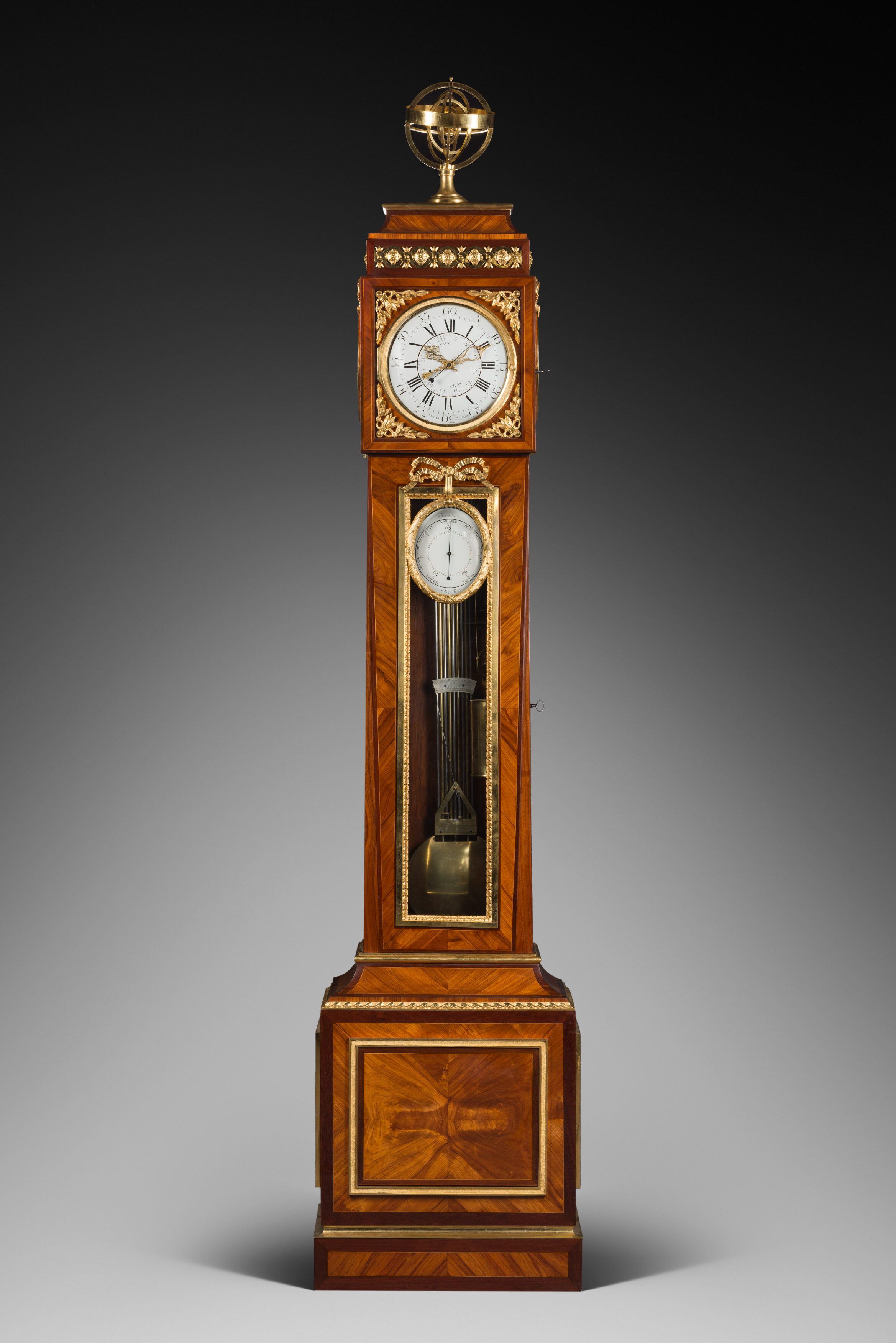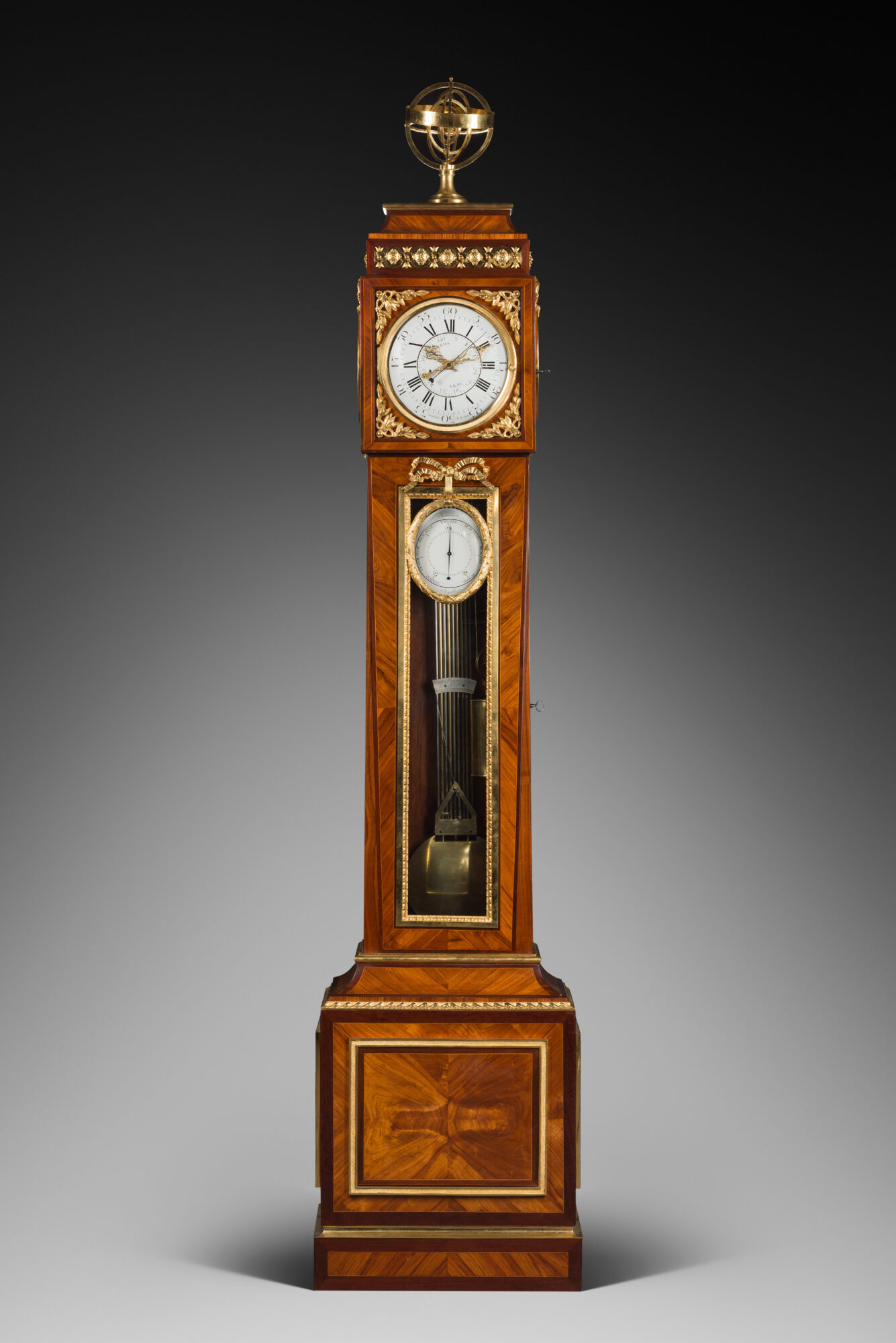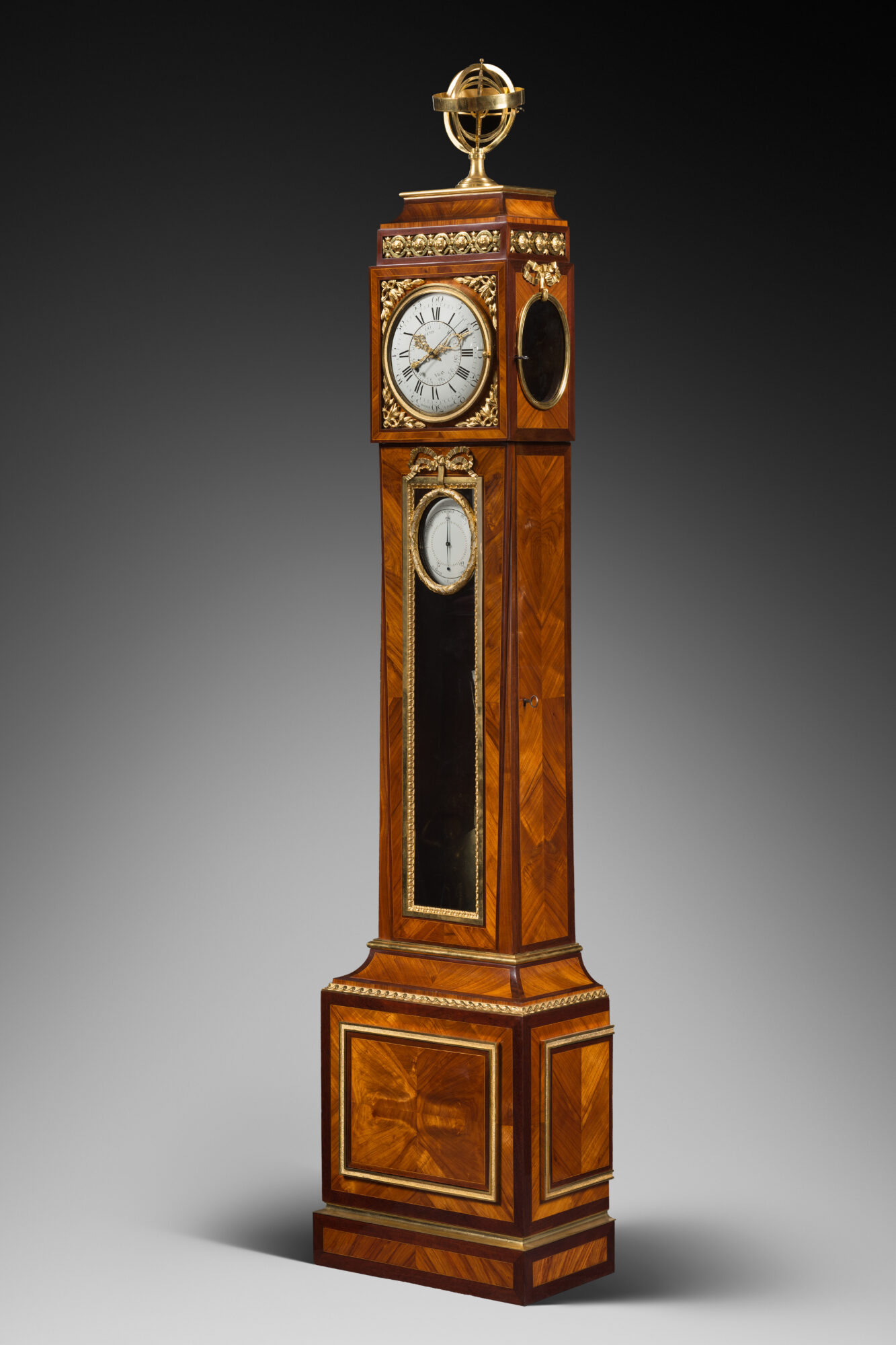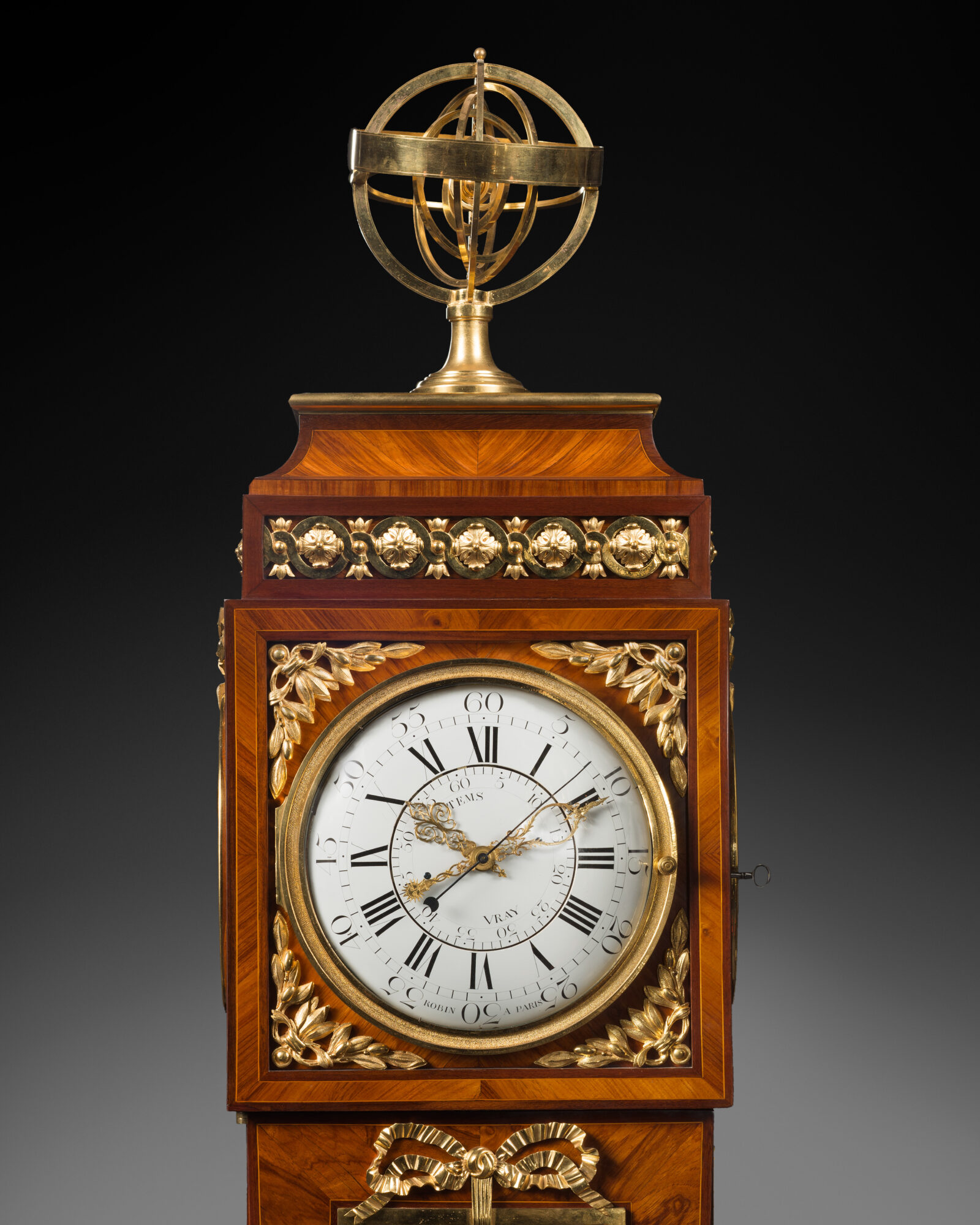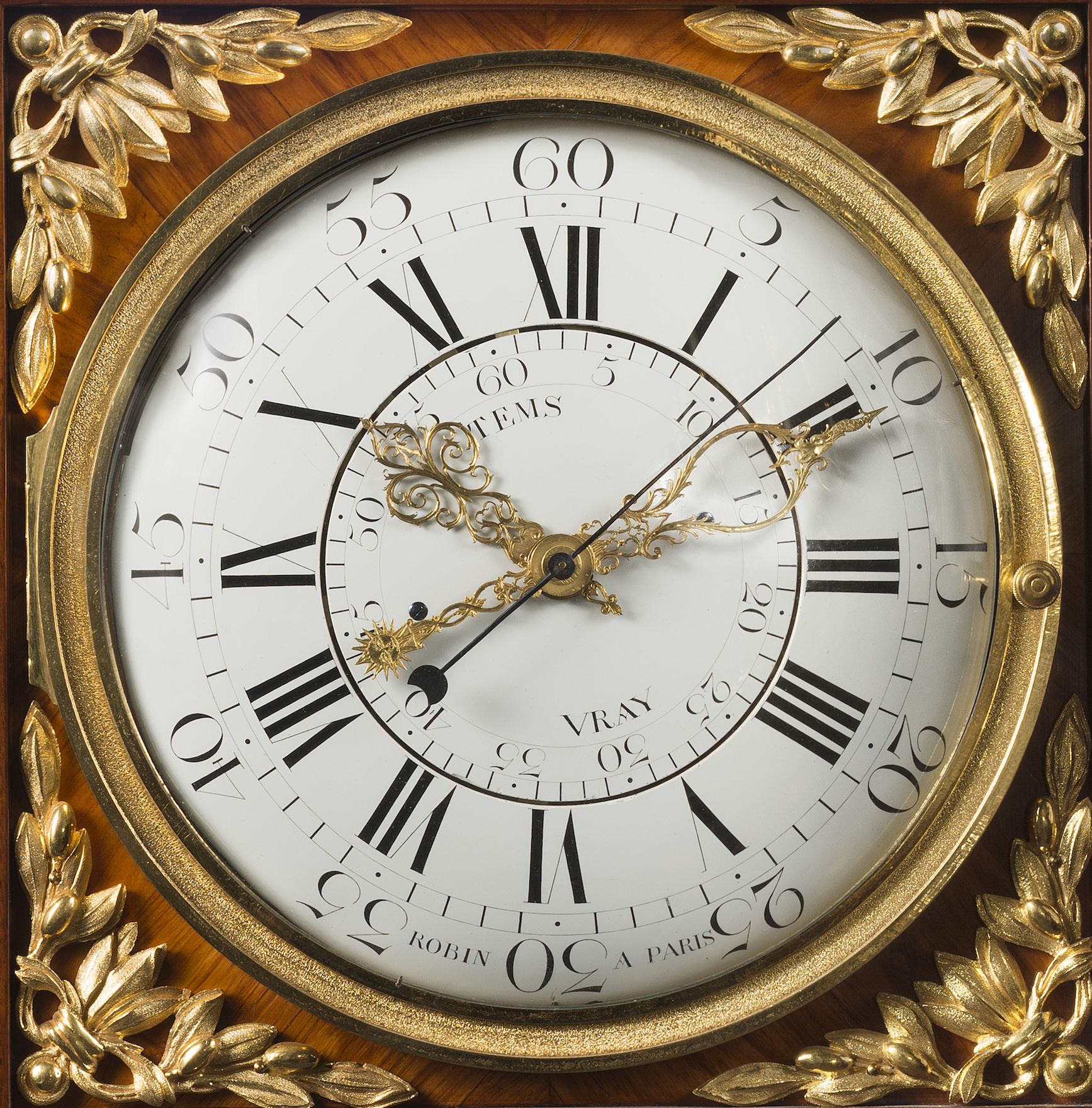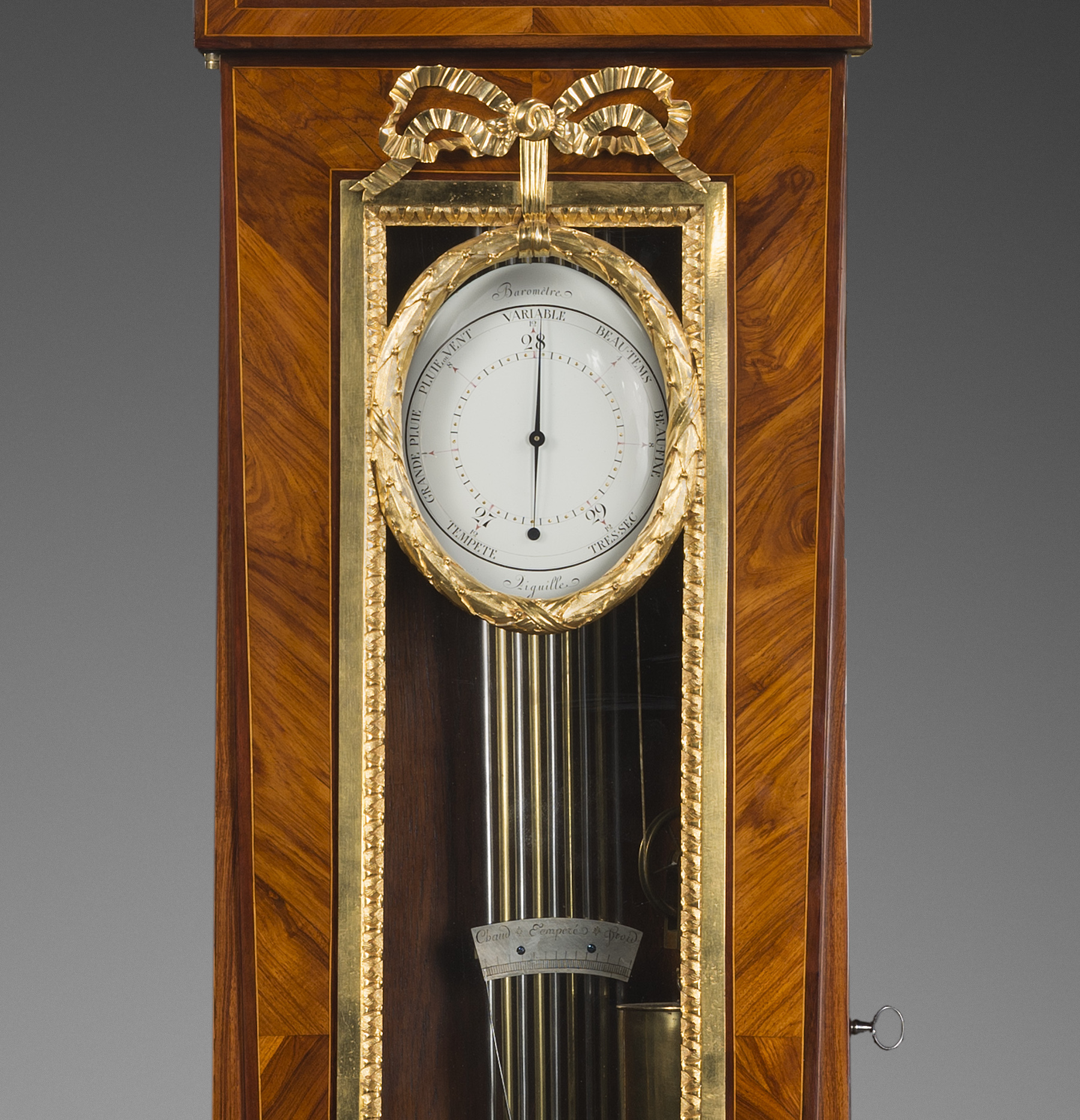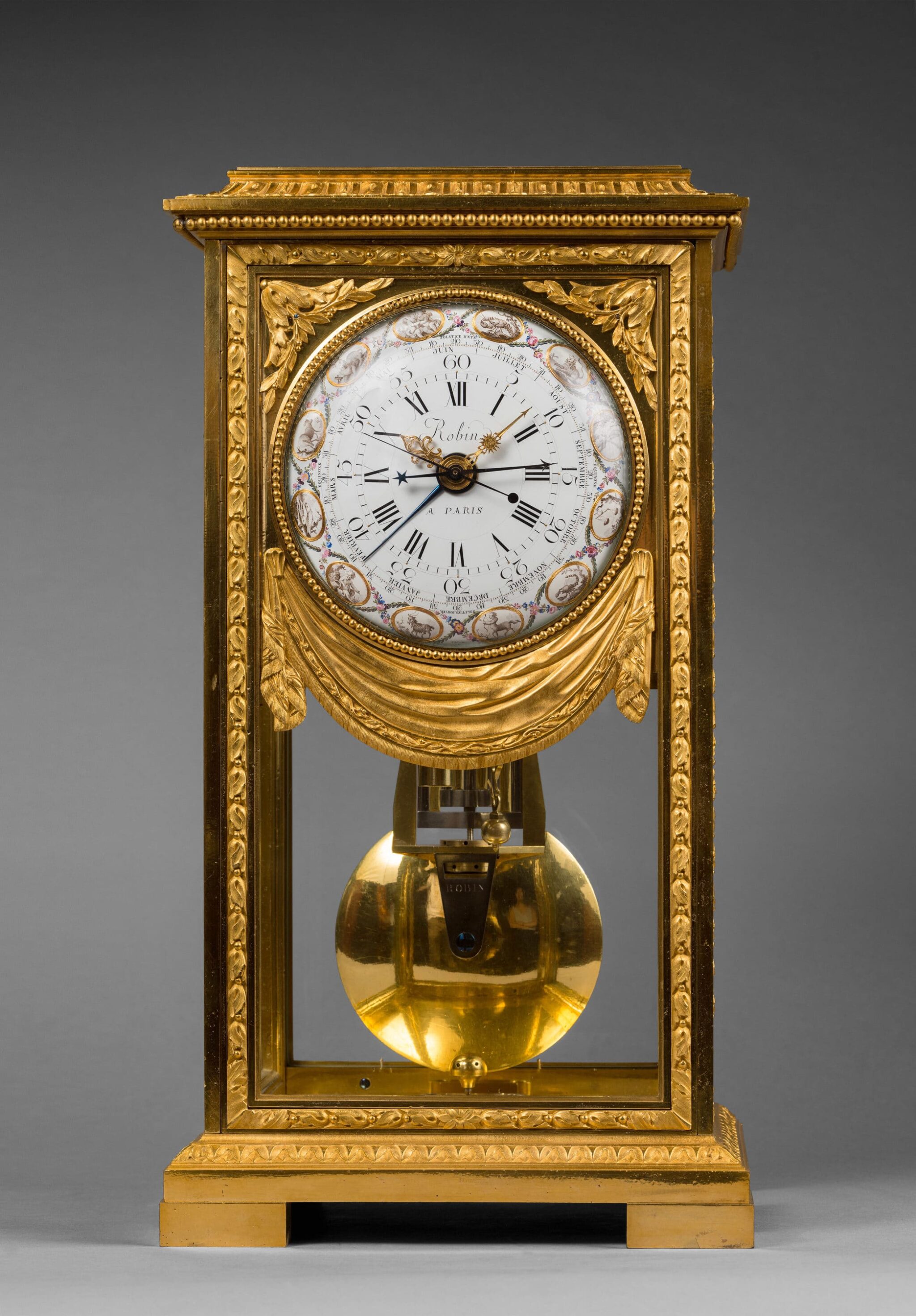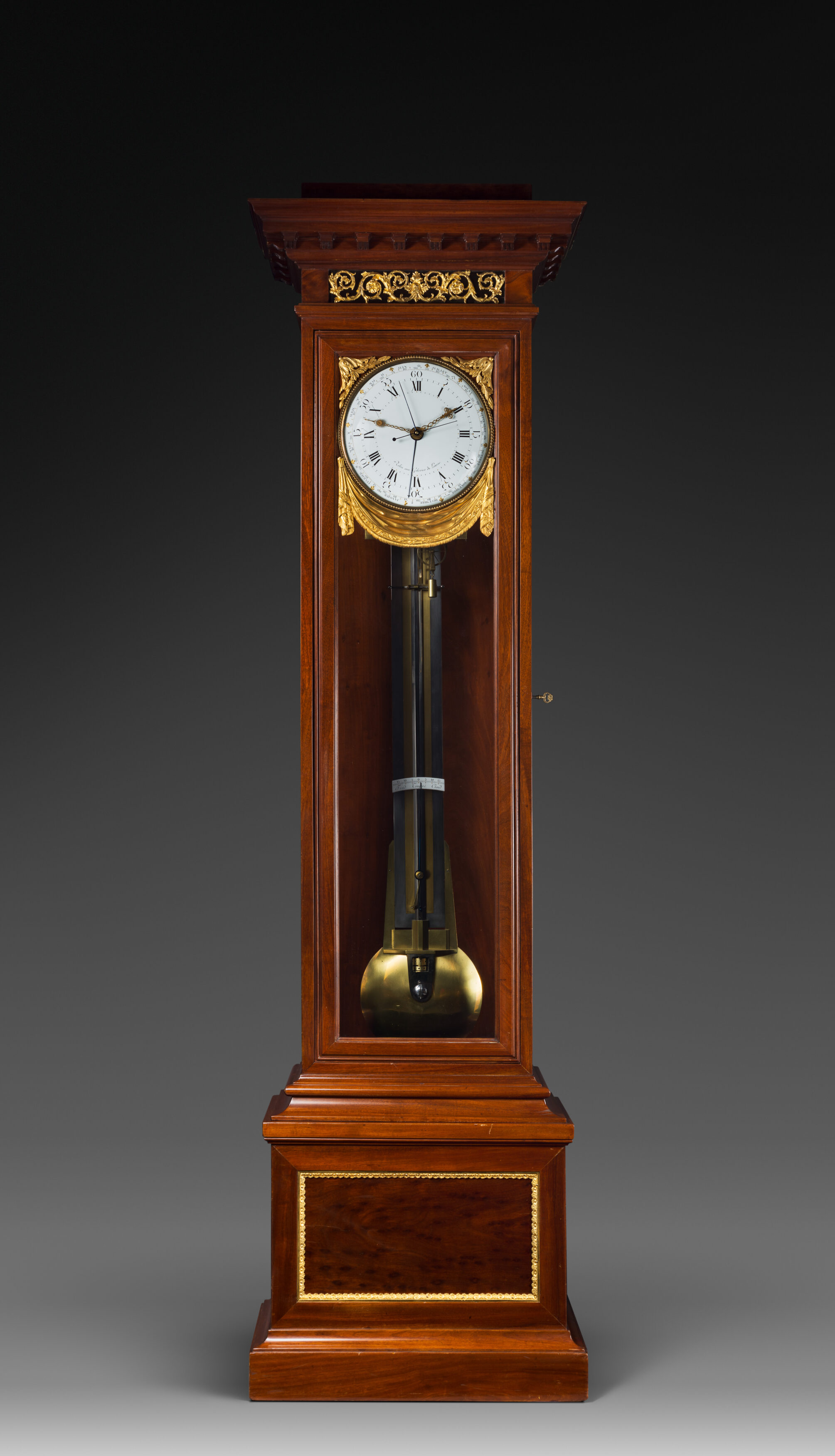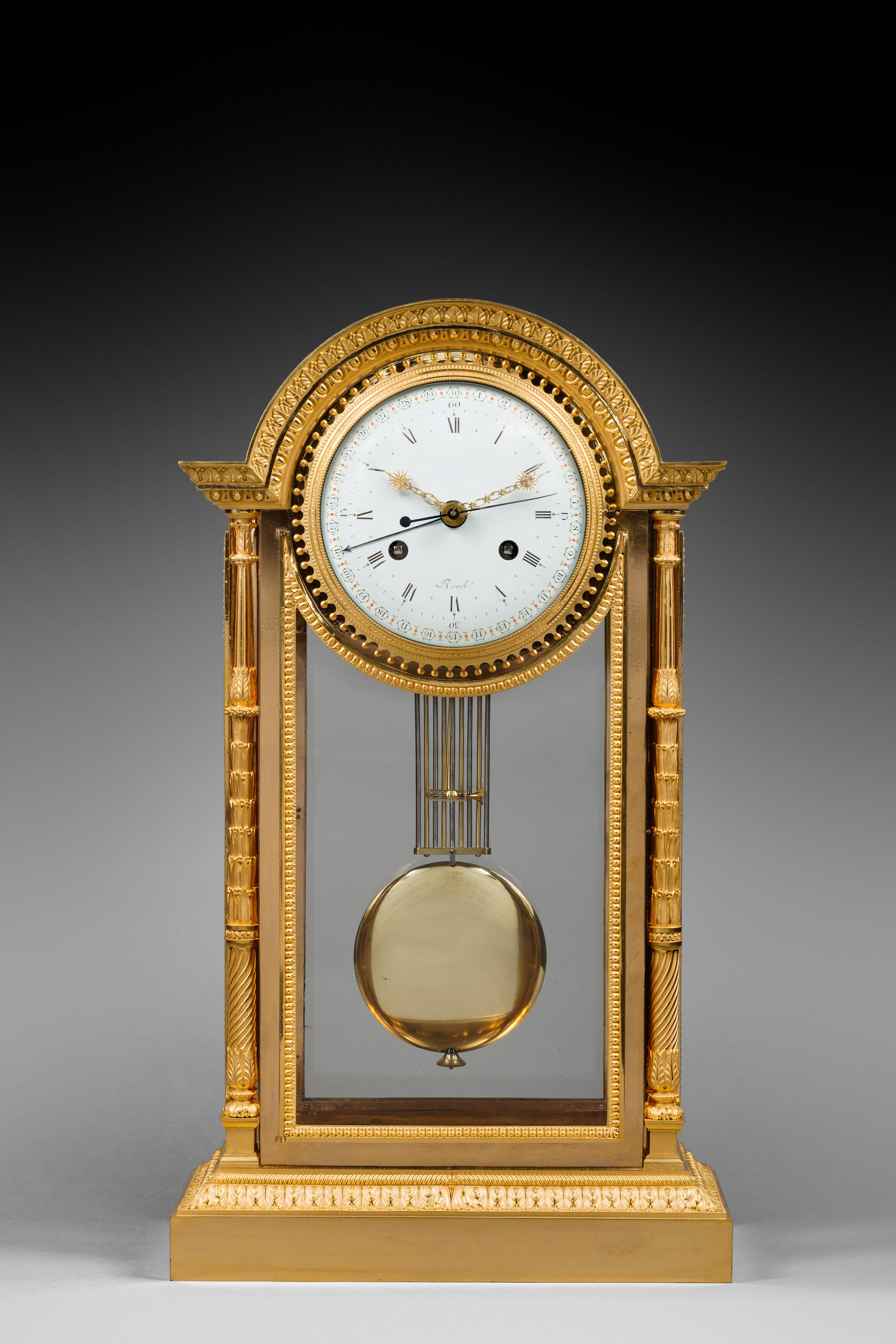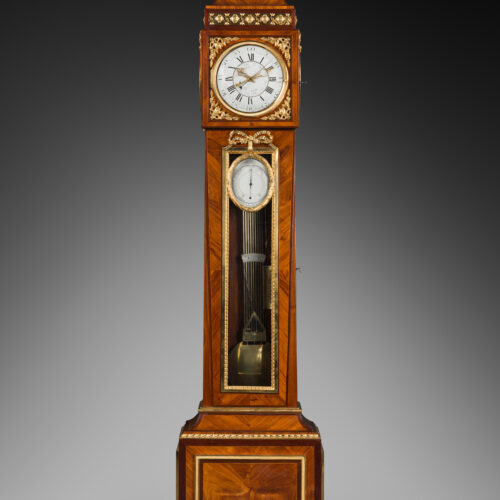Important Rosewood Veneer, Amaranth and Gilt Bronze Longcase Regulator with Equation of Time, Barometer and Thermometer
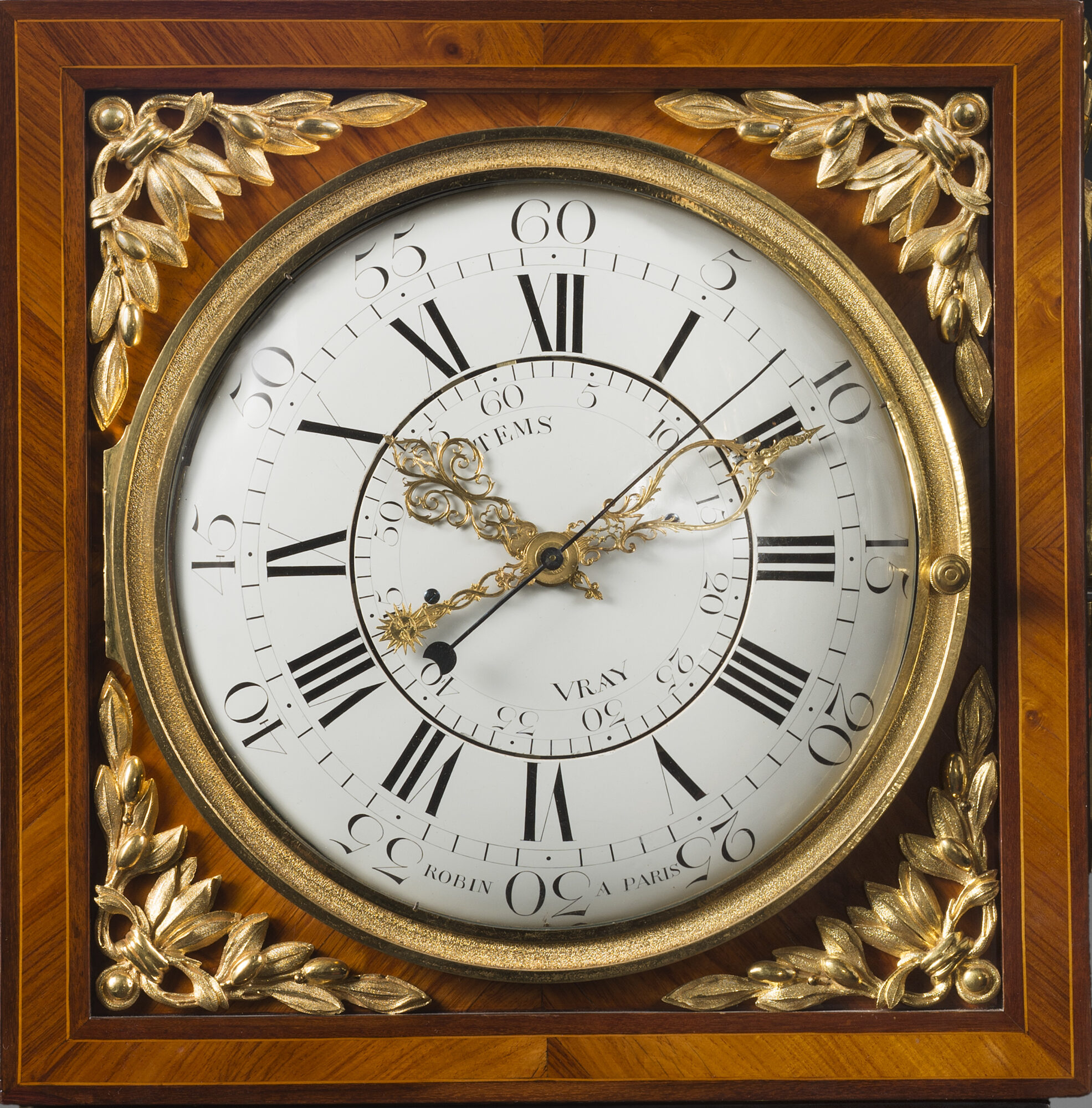
The dial signed by the clockmaker Robert Robin
The counter enamel signed by enameler Elie Barbezat and dated 1776
Stamped: “B LIEUTAUD” on the back of the case
Paris, early Louis XVI period, 1776
The white enamel dial, signed “Robin à Paris”, indicates the Roman numeral hours and Arabic numeral five-minute intervals by means of two pierced gilt bronze hands; the seconds are indicated by a central hand. A second round dial indicates the equation of time, i.e. the difference between true time – or solar time – and mean time. The façade also features a barometer that measures atmospheric pressure. The counter enamel is signed by the enameler “Barbezat” and is dated “1776”. The movement, with a bimetallic pendulum and large bob, bears a thermometer indicating metal dilation. It is housed in a rosewood-veneered case with amaranth wood frames flanked by bands of lighter colored wood. The case is elaborately decorated with finely chased gilt bronze mounts including plain frames, matted reserves, friezes, molding decorated with stiff leaf motifs, plain medallions, ribbon-tied laurel toruses, and olive and laurel branch spandrels. It is surmounted by a concave entablature that surmounts an interlace frieze centered by rosettes, and is topped by an armillary sphere set on a molded pedestal.
Discover our entire collection of antique regulator clocks for sale online or at the gallery.
The unusual design of this important longcase regulator was created by cabinetmaker Balthazar Lieutaud during the early years of the reign of Louis XVI. The cabinetmaker, who specialized in clock cases, produced several comparable pieces featuring variations in the chased gilt bronze mounts. One such model was in the collection of Joseph Bardac (sold Paris, Me Lair-Dubreuil, December 9, 1927, lot 118). A second example, surmounted by the figure of Father Time, is in the Victoria and Albert Museum in London (illustrated in O. Bracket, Catalogue of the Jones collection, V&A Museum). Three simpler examples are illustrated in Jean Nicolay, L’art et la manière des maîtres ébénistes français au XVIIIe siècle. During the 18th century, a similar regulator belonged to the well-known scientist and aviation pioneer Jean-François Pilâtre de Rosier (1754-1785): “A clock bearing the name of the Robin, clockmaker in Paris, striking the hours and half hours, marking the seconds, and containing a barometer, in its square rosewood-veneered case, with enamel dial and gilt copper ornaments, 1800 livres”.
Robert Robin (1741 - 1799)
Having become a master horologist in November 1767, he was one of the most important Parisian horologists of the last third of the 18th century. He received the honorary titles of Valet de Chambre-Horloger Ordinaire du Roi et de la Reine in 1783 and 1786. He enjoyed an extraordinary career, distinguishing himself by his exceptional contribution toward the improvement of time measuring instruments.
In 1778, the Academy of Sciences approved two of his inventions, one of which led to the construction of an astronomic clock with a meridian traced on a pyramid, which was acquired by the Menus Plaisirs for Louis XVI that same year; Robin published a very detailed historical and mechanical description of that clock. He also made mantel regulators with astronomic indications and compensation balance, of which the Marquis de Courtanvaux, a man of science and a great connoisseur of precision horology, was one of the earliest acquirers. During the Revolution he made decimal watches and clocks. He worked in the Grande rue du Faubourg Saint-Honoré (1772), the rue des Fossés-Saint-Germain l’Auxerrois (1775), the rue Saint-Honoré in the l’Hôtel d’Aligre (1778) and the Galeries du Louvre in 1786.
For his desk regulators, Robin chose very sober architectural cases, which look extraordinarily modern to contemporary viewers. He always worked with the finest artisans of the day, including the bronziers and chasers Robert and Jean Baptiste Osmond, Pierre Philippe Thomire, François Rémond and Claude Galle, the cabinetmakers Jean-Henri Riesener, Ferdinand Schwerdfeger and Adam Weisweiler, the enamellers Barbezat, Dubuisson, Merlet and Coteau for the dials, and Richard and Montginot for the springs.
Robert Robin’s two sons, Nicolas Robert (1775-1812) and Jean-Joseph (1781-1856), were also fine clockmakers and ably continued to run their father’s workshop.
Discover our entire collection of rare clocks on La Pendulerie Paris.
Balthazar Lieutaud (d. 1780) is one of the most important cabinetmakers of the Louis XV period and the early neoclassical period, he was born into a family of Parisian furniture makers – his father and grandfather were both cabinetmakers. He became a master in March 1749, opening a workshop in the rue de la Pelleterie, then in the rue Denfer. He specialised in regulator and cartel cases for which the gilt bronze mounts were made by the best bronziers and chasers of the time, including Charles Grimpelle and the Caffieri.
Elie Barbezat is an enameler specialized in dials. He had his practice on rue Bertin Poiré from 1768, and was one of the finest enamellers of the second half of the 18th century. Few enamellers are referenced and researched, but the corpus of his work reveals an activity concentrated between the end of the reign of Louis XV and the first years of the reign of Louis XVI. We estimate that he was mainly active between 1768 and 1776.
He worked with the best clockmakers of the time: Lepaute, Pierre III Leroy and Robert Robin. His signature can also be found on magnificent clocks by Beauvarlet, Peignat, Jean-Gabriel Imbert dit l’aîné and Ragot.
He took on Georges-Adrien Merlet as an apprentice in his workshop on October 30, 1767, and probably trained him to become his successor. His training was successful, as Merlet went on to become one of the top three enamellers of his time, along with Joseph Coteau and Dubuisson.
According to the Brateau Archives, Elie Barbezat was admitted to the Académie de Saint-Luc as a master painter on November 6, 1777.
